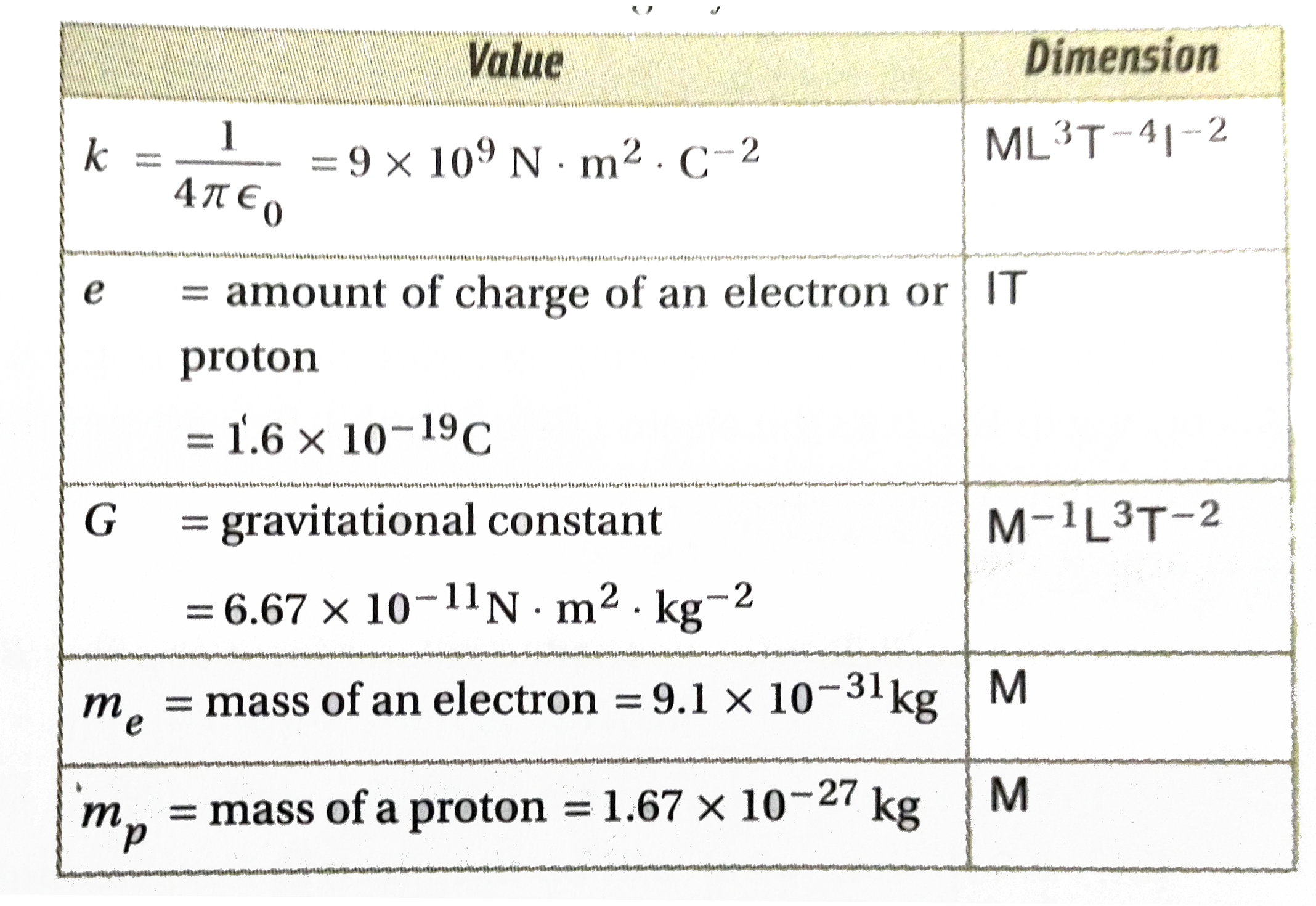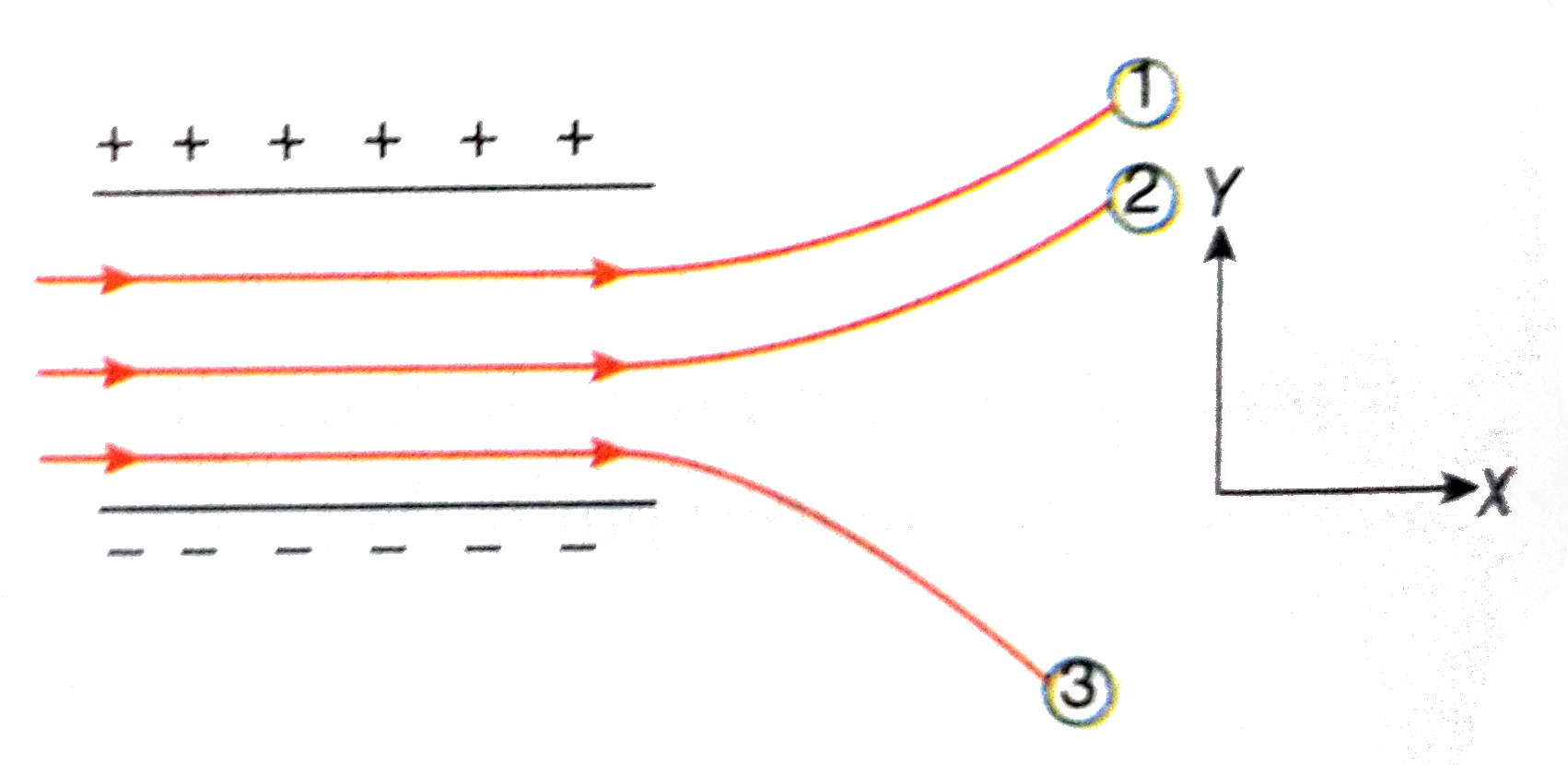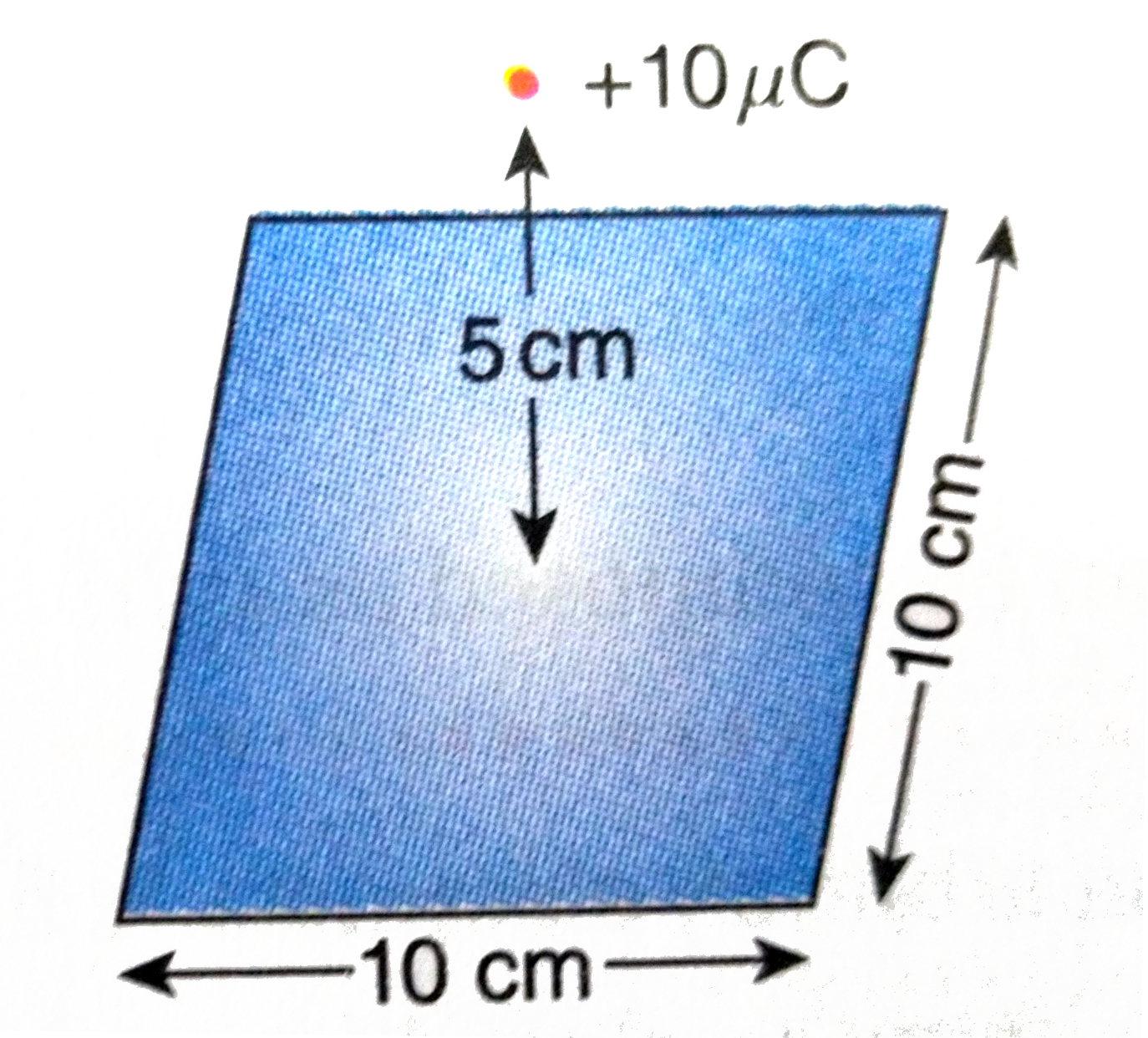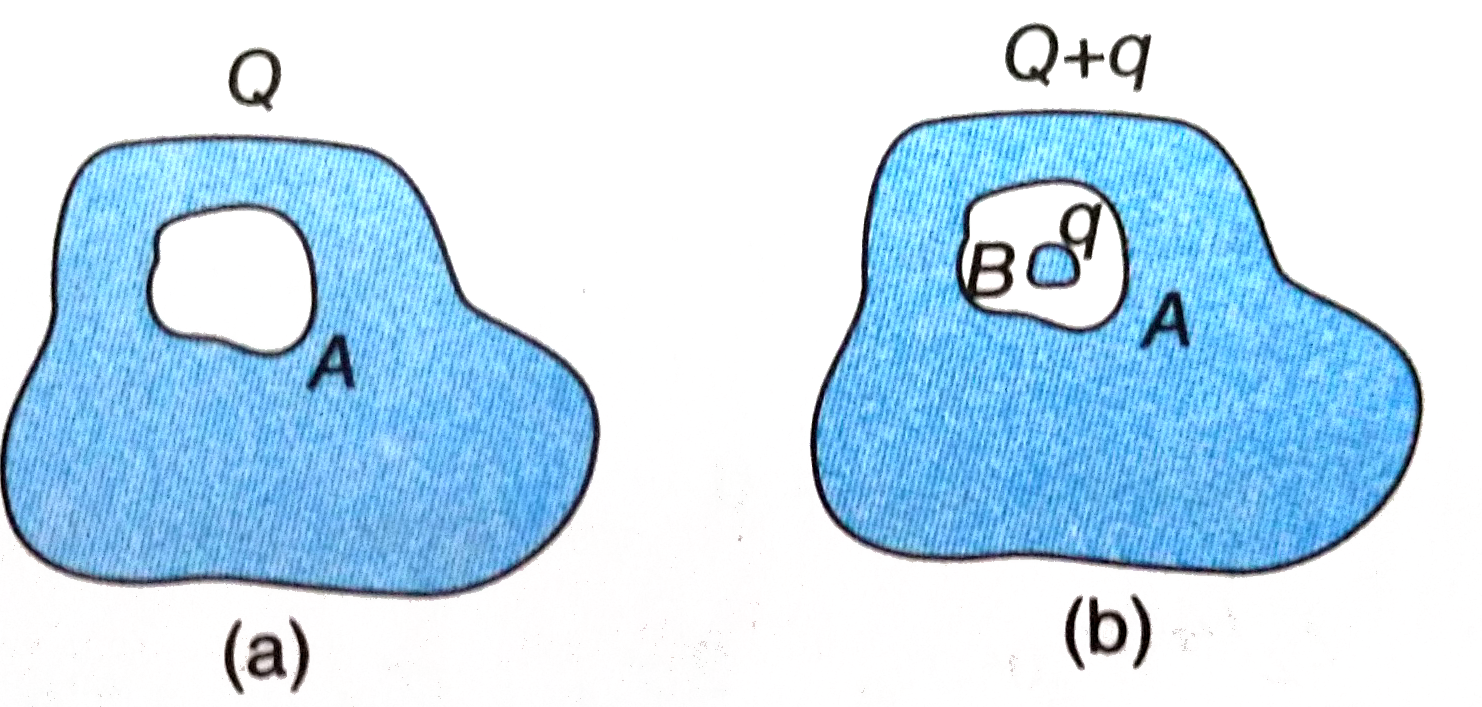Complete Solutions to NCERT TEXTBOOK QUESTIONS WITH ANSWER HINT of chapter ELECTRIC FIELD of Class 12 book with complete answers and questions
| Class 12 | PHYSICS |
| Chapter | ELECTRIC FIELD |
| CHHAYA PRAKASHINI | NCERT TEXTBOOK QUESTIONS WITH ANSWER HINT |
| Number Of Questions | 24 |
| Academic Year | 2023-24 |
An electrostatic field is a continuous curve. That is, a field line cannot have sudden breaks. Why not?
View SolutionCheck that the ratio `ke^(2)//Gm_(e)m_(p)` is dimensionless. From the table of physical constants, determine the value of this ratio. What does the ratio signify?

View SolutionFig. shows the track of three charged particles in uniform electrostatic field. Give the signs of the three charges. Which particles has the highest charge to mass ratio.

View SolutionCareful measurement of the electric field at the surface of a black box indicates that the net outward flux through the surface of the box is `8.0 xx 10^(3)N*m^(2)*C^(-1)`.
(a) What is the net charge inside the box?
(b) If the net outward flux through the surface of the box where zero, could you conclude that there where no charges inside the box? Why or why not ?
View SolutionA point charge of `10mu C ` is a placed at a distance 5 cm directly above the centre of a square of side 10cm, as shown in figure. What is the magnitude of the electric flux through the square .

View SolutionA conducting sphere of radius 10 cm has an unknown charge. If the electric field 20cm from the centre of the sphere is `1.5 xx 10^(3) N.C^(-1)` and points radially inward, what is the net charge on the sphere ?
View SolutionTwo large, thin metal plates are parallel and close to each other. On their inner faces, the plates have surface charge densities of opposite signs and of magnitude `17.0 xx 10^(-22) C .m^(-2)` .What is the electric field
In the outer region of the first plate ?
View SolutionTwo large, thin metal plates are parallel and close to each other. On their inner faces, the plates have surface charge densities of opposite signs and of magnitude `17.0 xx 10^(-22) C .m^(-2)` .What is the electric field
In the outer region of the second plate ?
View SolutionTwo large, thin metal plates are parallel and close to each other. On their inner faces, the plates have surface charge densities of opposite signs and of magnitude `17.0 xx 10^(-22) C .m^(-2)` .What is the electric field
between the plate ?
View SolutionIn a certain region of space, electric field is along the z-direction throughout. The magnitude of the electric field is, however, not constant but increases uniformly along the positive z-direction, at the rate of `10^(5) N.C^(-1)` per metre. What are the force and torque experienced by a system having a total dipole moment equal to `10^(-7)` C. m in the negative z-direction.
View SolutionA conductor A with a cavity as shown in Figure is given a charge Q. Show that the entire charge must appear on the outer surface of the conductor.
View SolutionA hollow sphere `A` is taken with charge `Q` on it. Another conductor `B` with charge `q` is inserted into the cavity keeping `B` insulated from `A`. Show that the total charge on the outside the surface of A is `(Q + q).`
View SolutionA sensitive instrument is to be shielded from the strong electrostatic fields in its environments . Suggest a possible way.

View SolutionA hollow charged conductor has a tiny hole cut into its surface. Show that the electric field in the hole is `(sigma)/( in_(0))hat(n)`, where `hat(n)` is the unit vector in the outward direction, and `sigma` is the surface density of charge near the hole .
View SolutionIt is now believed that protons and neutrons ( which constitute nucleI of ordinary matter ) are themselves built out of more elementary units called quarks. A proton and a neutron consist of three quarks each. Two types of quarks, the so called 'up' quark ( denoted by 'u') and 'down' quark ( denoted by 'd') of charge `(2)/(3) e ` and `(-1)/(3) e` respectively , together with electrons build up ordinary matter. Suggest a possible quark composition of a proton and a neutron.
View SolutionConsider an arbitrary electrostatic field configuration A small test charge is placed at a null point ( i.e., where `vec(E) = 0)` of the configuration. Show that the equilibrium of the test charge is necessarily unstable.
View SolutionVerify this result for the simple configuration of two charges of the same magnitude and sign placed at a certain distance apart.
View SolutionAn infinite line charge produces a field of `9 xx 10^(4) N. C^(-1)` at a distance of 2 cm. Calculate the linear charge density.
View SolutionA spherical conductor of radius 12 cm has a charge of `1. 6 xx 10^(-7) C ` distributed uniformly on its surface. What is the electric field
inside the sphere ?
View SolutionA spherical conductor of radius 12 cm has a charge of `1. 6 xx 10^(-7) C ` distributed uniformly on its surface. What is the electric field
just outside the sphere ?
View SolutionA spherical conductor of radius 12 cm has a charge of `1. 6 xx 10^(-7) C ` distributed uniformly on its surface. What is the electric field
at a point 18 cm from the centre of the sphere ?
View SolutionTwo charge conducting spheres of radii a and b are connected to each other by a wire. What is the ratio of electric field at the surfaces of the two spheres ?
View SolutionTwo large conducting sphere carrying charges `Q_(1)` and `Q_(2)` are brought close to each other. Is the magnitude of the electrostatic force between them exactly given by `Q_(1) Q_(2) //4pi in_(0) r^(2)`, where r is the distance between their centres ?
View SolutionA small test charge is released at rest at a point in an electrostatic field configuration . Will it travel along the field line passing through that point ?
View Solution
NCERT TEXTBOOK QUESTIONS WITH ANSWER HINT questions and complete solutions for chapter ELECTRIC FIELD of CHHAYA PHYSICS (BENGALI ENGLISH) of Class 12
All Exercises from CHHAYA PRAKASHINI Class 12 PHYSICS ELECTRIC FIELD
- CBSE SCANNER
- ENTRACNCE CORNER ( COMPREHENSION TYPE )
- ENTRACNCE CORNER ( INTEGER ANSWER TYPE )
- ENTRACNCE CORNER (ASSERTION-REASON TYPE )
- ENTRACNCE CORNER (MULTIPLE CORRECT ANSWER TYPE )
- EXAMINATION ARCHIVE ( AIPMT)
- EXAMINATION ARCHIVE ( JEE MAIN )
- EXAMINATION ARCHIVE ( NEET )
- EXAMINATION ARCHIVE (WBCHSE)
- EXAMINATION ARCHIVE (WBJEE)
- EXERCISE ( HOTS NUMERICAL PROBLEMS )
- EXERCISE ( MULTIPLE CHOICE QUESTION )
- EXERCISE ( VERY SHORT ANSWER TYPE QUESTIONS )
- EXERCISE (PROBLEM SET -I)
- EXERCISE (PROBLEM SET -II)
- EXERCISE (SHORT ANSWER TYPE QUESTIONS-I )
- EXERCISE (SHORT ANSWER TYPE QUESTIONS-II )
- HIGHER ORDER THINKING SKILL QUESTIONS
- NCERT EXEMPLAR QUESTIONS WITH ANSWER HINT
- NCERT TEXTBOOK QUESTIONS WITH ANSWER HINT
- NUMERICAL EXAMPLES
- SECTION RELATION QUESTIONS